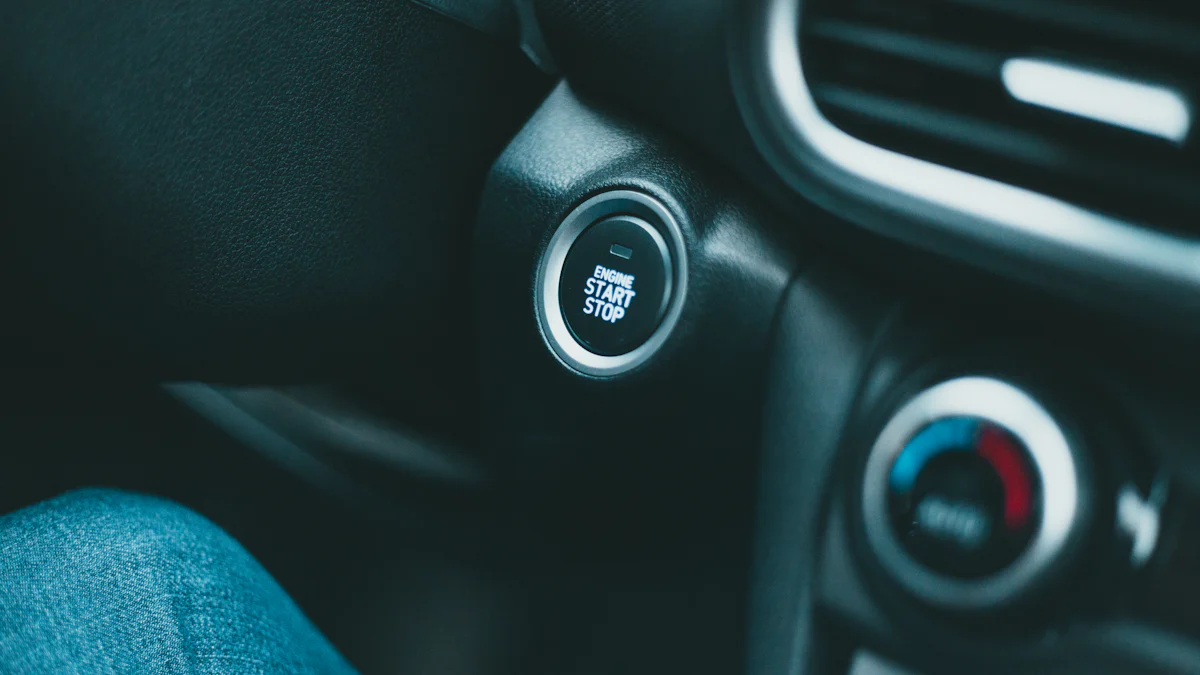El futuro del aligeramiento en automoción a través de la innovación de materiales

Reducing vehicle weight plays a vital role in improving both sustainability and efficiency in modern transportation. A 10% reduction in weight can boost fuel economy by 6% to 8%, while cutting CO2 emissions by 3% to 5%. Automotive lightweight materials, such as advanced composites and alloys, replace traditional steel components, reducing vehicle mass by up to 50%. This shift not only enhances performance but also aligns with the growing demand for eco-friendly solutions. Automotive lightweighting, driven by material innovation, ensures vehicles meet stricter emissions standards while maintaining safety and durability.
Principales conclusiones
Reducing vehicle weight by just 10% can improve fuel economy by 6% to 8% and cut CO2 emissions by 3% to 5%.
Advanced materials like carbon fiber-reinforced polymers (CFRPs) and aluminum-magnesium alloys are key to achieving significant weight reductions while maintaining performance and safety.
Utilizing glass fiber composites offers a cost-effective solution for mass-market vehicles, ensuring that even budget-friendly options benefit from lightweight design.
Innovative manufacturing techniques such as hot stamping, hydroforming, and 3D printing enable the creation of complex, lightweight components that enhance efficiency and reduce waste.
Hybrid materials that combine metals and composites optimize strength and weight, supporting sustainability by minimizing overall material usage.
Lightweighting is crucial for electric vehicles, as it directly impacts energy efficiency and extends battery range, making them more competitive in the market.
Continuous research and development in lightweight materials will drive future innovations, ensuring that the automotive industry meets evolving efficiency and sustainability standards.
Material Innovations in Automotive Lightweighting

Advanced Composites for Lightweight Vehicles
Carbon fiber-reinforced polymers (CFRPs) for high-performance and electric vehicles
You encounter carbon fiber-reinforced polymers (CFRPs) in many cutting-edge automotive designs. These materials deliver exceptional strength while significantly reducing weight. CFRPs boast a high strength-to-weight ratio, making them ideal for electric vehicles and high-performance cars. By replacing traditional steel components, CFRPs can reduce peso del vehículo by up to 10% compared to fiberglass-reinforced composites. This reduction enhances both efficiency and performance, especially in battery electric vehicles, where every pound saved translates to extended range and better energy utilization.
Glass fiber composites as cost-effective solutions for mass-market lightweighting
For mass-market vehicles, glass fiber composites offer a practical and affordable solution. These materials provide a balance between cost and performance, making them suitable for large-scale production. While not as strong as CFRPs, glass fiber composites still contribute to lightweighting efforts by replacing heavier materials in non-structural parts. Their use ensures that even budget-friendly vehicles benefit from diseño ligero, improving fuel economy and reducing emissions.
Novel Alloys in Automotive Lightweight Materials
Aluminum-magnesium alloys for lightweight structural applications
Aluminum-magnesium alloys have become a cornerstone of automotive lightweighting. These alloys combine the corrosion resistance of aluminum with the strength of magnesium, creating a material perfect for structural components. You’ll find these alloys in body panels, engine blocks, and suspension systems. Their use reduces peso del vehículo without compromising durability or safety, which is critical for both traditional and electric vehicles.
High-strength and ultra-high-strength steels for balancing weight, safety, and cost
Steel remains a vital material in automotive applications, but modern advancements have led to high-strength and ultra-high-strength steels. These steels allow manufacturers to reduce material thickness while maintaining safety standards. Hot stamping processes further enhance their properties, enabling complex shapes for diseño ligero. This approach balances cost-effectiveness with lightweighting goals, ensuring that safety and affordability remain priorities.
Hybrid and Sustainable Materials
Combining metals and composites for multi-functional lightweight structures
Hybrid materials represent a significant innovation in automotive lightweighting. By combining metals like aluminum or steel with composite materials, manufacturers create multi-functional structures that optimize strength, weight, and performance. For example, hybrid door panels or chassis components integrate the best properties of each material, resulting in superior diseño ligero. These combinations also support sustainability by reducing the overall material usage.
Bio-based materials as eco-friendly alternatives for automotive lightweighting
As the industry shifts toward sustainability, bio-based materials are gaining traction. These materials, derived from renewable sources, offer an eco-friendly alternative to traditional lightweight materials. You might see bio-based composites used in interior panels, seat cushions, or trim components. Their adoption not only supports lightweighting but also aligns with the growing demand for greener manufacturing practices.
Structural Lightweighting Strategies in Automotive Design

Advanced Forming Technologies for Lightweight Components
Hot stamping and hydroforming for complex, lightweight designs
Hot stamping and hydroforming have revolutionized the way lightweight components are manufactured. These advanced forming technologies allow you to create intricate shapes while maintaining the strength and durability of the material. Hot stamping involves heating steel to high temperatures, making it malleable enough to form complex parts. Once cooled, the material retains its enhanced strength, which is essential for safety-critical automotive applications. Hydroforming, on the other hand, uses pressurized fluid to shape lightweight materials like aluminum into precise forms. This process minimizes material waste and ensures consistent quality, making it ideal for achieving lightweight design in both traditional and electric vehicles.
By adopting these methods, manufacturers achieve significant vehicle weight reduction without compromising structural integrity. This not only improves fuel efficiency but also enhances the performance of battery electric vehicles by extending their range. These technologies represent a key strategy in automotive lightweighting, enabling the production of components that are both efficient and cost-effective.
Incremental sheet forming for small-batch production of lightweight parts
Incremental sheet forming offers a flexible solution for producing lightweight parts in small quantities. Unlike traditional stamping methods, this technique uses a tool to gradually deform a sheet of material into the desired shape. You can use this method to create custom or prototype parts without the need for expensive molds or dies. This makes it particularly useful for electric vehicles, where unique designs and lightweight materials are often required.
The process also supports sustainability by reducing material waste and energy consumption. Incremental sheet forming allows you to experiment with hybrid materials and composite materials, opening up new possibilities for lightweight design. This approach ensures that even low-volume production runs can benefit from the latest advancements in automotive lightweighting.
Design Optimization for Lightweighting
Generative design and topology optimization to minimize material usage
Generative design and topology optimization are cutting-edge tools that help you achieve lightweighting goals by minimizing material usage. Generative design uses algorithms to explore thousands of design possibilities based on specific parameters like weight, strength, and efficiency. This technology enables you to create innovative structures that use the least amount of material while meeting performance requirements.
Topology optimization, on the other hand, focuses on removing unnecessary material from existing designs. By analyzing stress distribution and load paths, this method identifies areas where material can be reduced without affecting functionality. These techniques are particularly valuable in the development of electric vehicles, where every ounce saved contributes to better energy efficiency and extended battery life. They also align with sustainability efforts by reducing material waste and promoting efficient use of resources.
Multi-material joining techniques for integrating diverse lightweight materials
Integrating diverse lightweight materials into a single component requires advanced joining techniques. Multi-material joining allows you to combine materials like aluminum, steel, and composite materials to create hybrid structures that optimize weight and performance. Techniques such as adhesive bonding, laser welding, and mechanical fastening ensure strong and durable connections between different materials.
These methods are essential for achieving lightweight design in complex automotive applications. For example, you might use multi-material joining to create a lightweight chassis that combines the strength of steel with the flexibility of aluminum. This approach not only reduces vehicle weight but also enhances safety and durability. By leveraging these techniques, manufacturers can push the boundaries of automotive lightweighting and deliver vehicles that are both efficient and sustainable.
System-Level Approaches to Automotive Lightweighting
Additive Manufacturing in Lightweighting
3D printing of lightweight components with intricate geometries
Additive manufacturing, commonly known as 3D printing, has revolutionized automotive lightweighting. This technology allows you to create intricate geometries that were previously impossible with traditional manufacturing methods. By layering materials precisely, 3D printing minimizes waste and optimizes material usage. You can design lightweight components tailored to specific performance requirements, making it an ideal solution for electric vehicles.
For instance, 3D printing enables the production of custom parts like brackets, housings, and structural supports. These components use lightweight materials such as aluminum alloys or advanced composites, reducing vehicle weight without compromising strength. Studies, such as those published in Grand View Research y Springer, highlight how 3D printing facilitates structural optimization, resulting in significant weight reduction. This approach not only enhances efficiency but also aligns with sustainability goals by reducing material consumption.
Lattice structures for reducing weight while maintaining strength
Lattice structures represent a breakthrough in lightweighting strategies. These designs incorporate a network of interconnected patterns that reduce material usage while maintaining structural integrity. With 3D printing, you can easily create these complex structures, which are particularly valuable for electric vehicles. Lattice structures excel in applications where weight reduction is critical, such as battery enclosures or suspension components.
The mechanical evaluation of 3D-printed lattice structures, as noted in ePlus 3D, demonstrates their ability to balance weight and strength effectively. By integrating lattice designs into automotive components, you achieve lightweight design without sacrificing durability. This strategy supports vehicle weight reduction, improves energy efficiency, and enhances overall performance, especially in battery electric vehicles.
Lightweighting in Electric Vehicle Systems
Lightweight battery enclosures for improved energy efficiency
Battery enclosures play a crucial role in electric vehicles. These components protect the battery pack while contributing to the overall weight of the vehicle. By using lightweight materials like aluminum-magnesium alloys or advanced composites, you can significantly reduce the weight of battery enclosures. This reduction directly impacts energy efficiency, as lighter vehicles require less energy to operate.
Lightweight battery enclosures also improve thermal management, ensuring optimal battery performance. Research from PMC emphasizes how additive manufacturing enables the creation of lightweight and thermally efficient enclosures. This innovation enhances the range and efficiency of battery electric vehicles, making them more competitive in the automotive market.
Lightweight electric motors and drivetrains for enhanced performance
Electric motors and drivetrains are essential components of electric vehicles. Reducing their weight improves performance and extends the vehicle’s range. By incorporating lightweight materials and advanced manufacturing techniques, you can optimize these systems for efficiency and durability.
For example, lightweighting strategies for electric motors often involve the use of high-strength alloys or hybrid materials. These materials reduce the mass of motor housings and rotor components, enhancing energy efficiency. Similarly, lightweight drivetrains benefit from advanced composites and multi-material designs, which improve power delivery and reduce energy loss. These innovations ensure that electric vehicles remain at the forefront of automotive lightweighting advancements.
Automotive lightweighting has redefined how vehicles achieve efficiency, performance, and sustainability. By integrating advanced materials like composites, alloys, and hybrid solutions, manufacturers create lightweight designs that enhance fuel economy, reduce emissions, and improve handling. Structural strategies, such as generative design and advanced forming techniques, further optimize material usage. System-level approaches, including lightweight electric motors and battery enclosures, ensure electric vehicles deliver superior range and energy efficiency. As the industry evolves, lightweighting will remain a key strategy in shaping the future of electric and autonomous vehicles, driving innovation and transforming transportation.
PREGUNTAS FRECUENTES
What is lightweighting in the automotive industry?
Lightweighting refers to the process of reducing the weight of vehicles by replacing heavy components with lighter alternatives. For example, manufacturers often substitute steel panels and frames with materials like aluminum or carbon fiber. This approach enhances vehicle performance and improves fuel efficiency, making it a key strategy in modern automotive design.
How can lightweighting benefit the environment?
Lightweighting significantly reduces a vehicle’s environmental impact. By using materials such as high-impact polymers and light metals, vehicles become more eco-friendly. According to reports, every 10 pounds removed from a car can reduce carbon dioxide emissions by 10 to 15 pounds annually. This makes lightweighting an essential step toward sustainable transportation.
Why is research and development into lightweight materials essential?
Research and development play a crucial role in advancing lightweight materials. These efforts aim to lower costs, improve recyclability, and enhance integration into vehicles. Additionally, they maximize the fuel economy benefits of lightweighting, ensuring that both traditional and electric vehicles achieve optimal efficiency.
What materials are commonly used in automotive lightweighting?
Automotive lightweighting relies on materials like aluminum, magnesium alloys, carbon fiber-reinforced polymers, and glass fiber composites. These materials offer a balance of strength, durability, and reduced weight, making them ideal for various automotive applications. Hybrid materials and bio-based alternatives are also gaining traction as sustainable options.
How does lightweighting impact electric vehicles?
Lightweighting is critical for electric vehicles. Reducing weight improves energy efficiency, extends battery range, and enhances overall performance. Lightweight materials are used in components like battery enclosures, electric motors, and drivetrains, ensuring that electric vehicles remain competitive and efficient.
Is lightweighting cost-effective for manufacturers?
Yes, lightweighting can be cost-effective in the long run. While advanced materials like carbon fiber may have higher initial costs, their benefits in fuel savings, reduced emissions, and improved performance outweigh the expenses. Additionally, ongoing research aims to make these materials more affordable for mass production.
What role do advanced manufacturing techniques play in lightweighting?
Advanced manufacturing techniques, such as hot stamping, hydroforming, and 3D printing, are pivotal in lightweighting. These methods allow for precise shaping of lightweight materials, minimizing waste and ensuring structural integrity. They also enable the creation of complex designs that optimize weight reduction without compromising safety.
Can lightweighting improve vehicle safety?
Yes, lightweighting can enhance safety when done correctly. High-strength materials like ultra-high-strength steel and aluminum-magnesium alloys maintain structural integrity while reducing weight. Advanced forming technologies ensure that lightweight components meet safety standards, providing protection for passengers.
How does lightweighting contribute to sustainable transportation?
Lightweighting supports sustainable transportation by reducing fuel consumption and emissions. It aligns with global efforts to create eco-friendly vehicles, particularly in the electric vehicle sector. By integrating recyclable and bio-based materials, lightweighting further promotes sustainability in the automotive lightweight materials market.
What is the future of lightweighting in the automotive industry?
The future of lightweighting lies in continuous innovation. As electric and autonomous vehicles dominate the market, lightweighting will remain a priority. Manufacturers will focus on developing advanced materials, optimizing designs, and adopting cutting-edge technologies to meet the demands of efficiency and sustainability.
